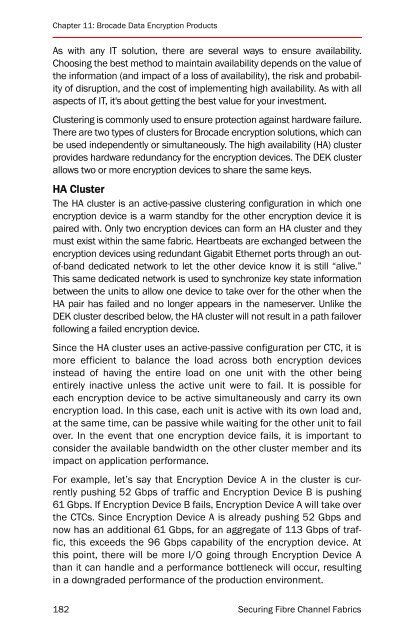SECURING FIBRE CHANNEL FABRICS - Brocade
SECURING FIBRE CHANNEL FABRICS - Brocade
SECURING FIBRE CHANNEL FABRICS - Brocade
- No tags were found...
Create successful ePaper yourself
Turn your PDF publications into a flip-book with our unique Google optimized e-Paper software.
Chapter 11: <strong>Brocade</strong> Data Encryption ProductsAs with any IT solution, there are several ways to ensure availability.Choosing the best method to maintain availability depends on the value ofthe information (and impact of a loss of availability), the risk and probabilityof disruption, and the cost of implementing high availability. As with allaspects of IT, it's about getting the best value for your investment.Clustering is commonly used to ensure protection against hardware failure.There are two types of clusters for <strong>Brocade</strong> encryption solutions, which canbe used independently or simultaneously. The high availability (HA) clusterprovides hardware redundancy for the encryption devices. The DEK clusterallows two or more encryption devices to share the same keys.HA ClusterThe HA cluster is an active-passive clustering configuration in which oneencryption device is a warm standby for the other encryption device it ispaired with. Only two encryption devices can form an HA cluster and theymust exist within the same fabric. Heartbeats are exchanged between theencryption devices using redundant Gigabit Ethernet ports through an outof-banddedicated network to let the other device know it is still “alive.”This same dedicated network is used to synchronize key state informationbetween the units to allow one device to take over for the other when theHA pair has failed and no longer appears in the nameserver. Unlike theDEK cluster described below, the HA cluster will not result in a path failoverfollowing a failed encryption device.Since the HA cluster uses an active-passive configuration per CTC, it ismore efficient to balance the load across both encryption devicesinstead of having the entire load on one unit with the other beingentirely inactive unless the active unit were to fail. It is possible foreach encryption device to be active simultaneously and carry its ownencryption load. In this case, each unit is active with its own load and,at the same time, can be passive while waiting for the other unit to failover. In the event that one encryption device fails, it is important toconsider the available bandwidth on the other cluster member and itsimpact on application performance.For example, let’s say that Encryption Device A in the cluster is currentlypushing 52 Gbps of traffic and Encryption Device B is pushing61 Gbps. If Encryption Device B fails, Encryption Device A will take overthe CTCs. Since Encryption Device A is already pushing 52 Gbps andnow has an additional 61 Gbps, for an aggregate of 113 Gbps of traffic,this exceeds the 96 Gbps capability of the encryption device. Atthis point, there will be more I/O going through Encryption Device Athan it can handle and a performance bottleneck will occur, resultingin a downgraded performance of the production environment.182 Securing Fibre Channel Fabrics

















